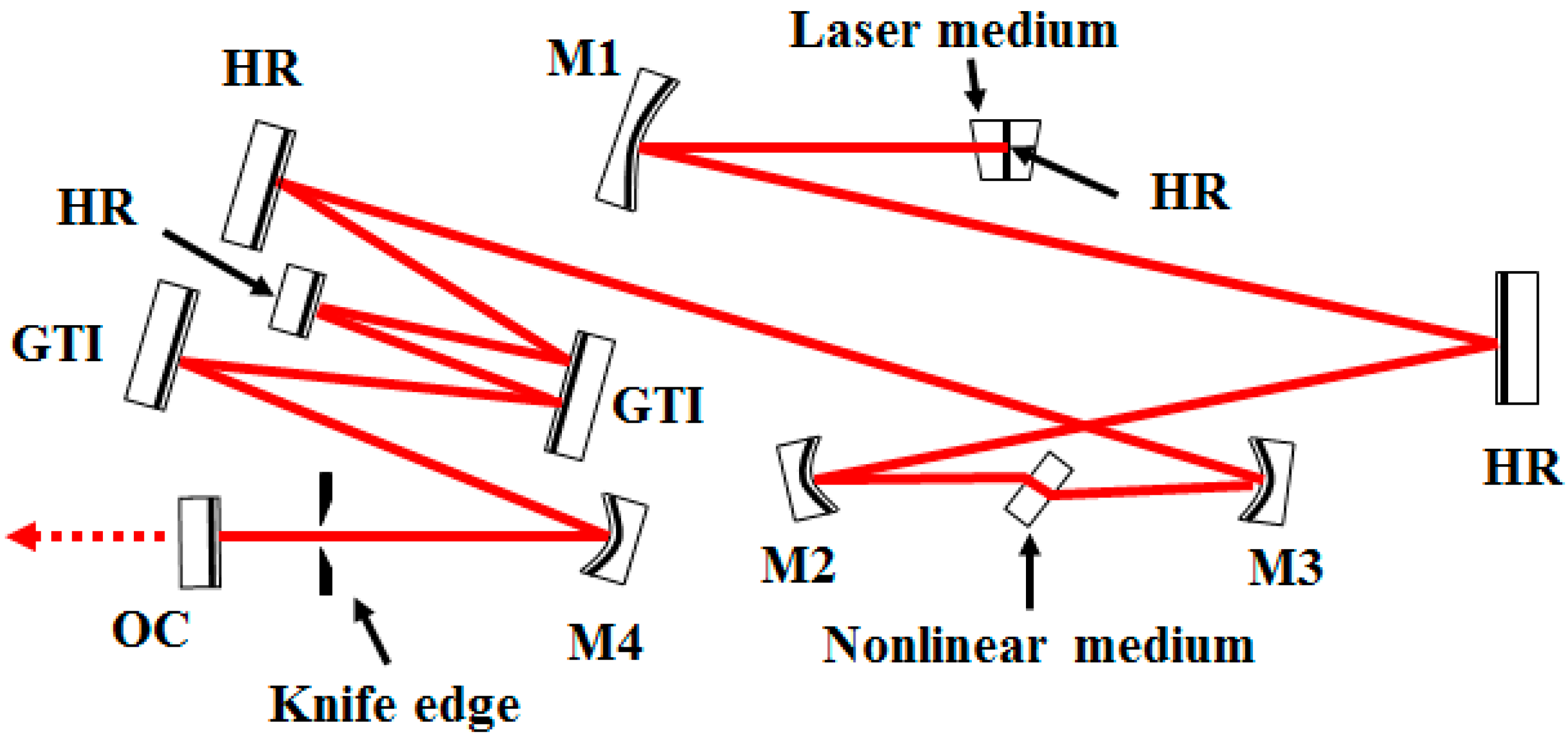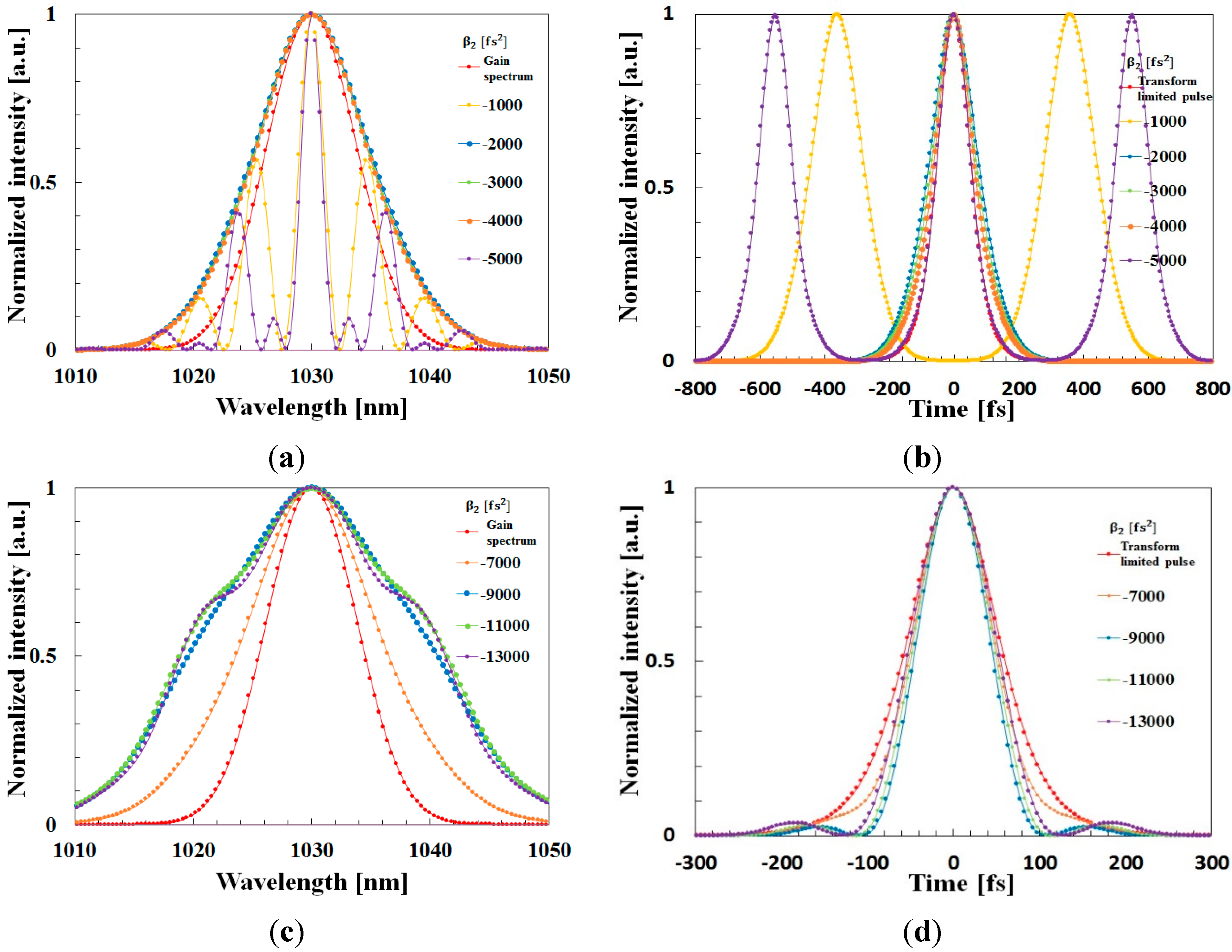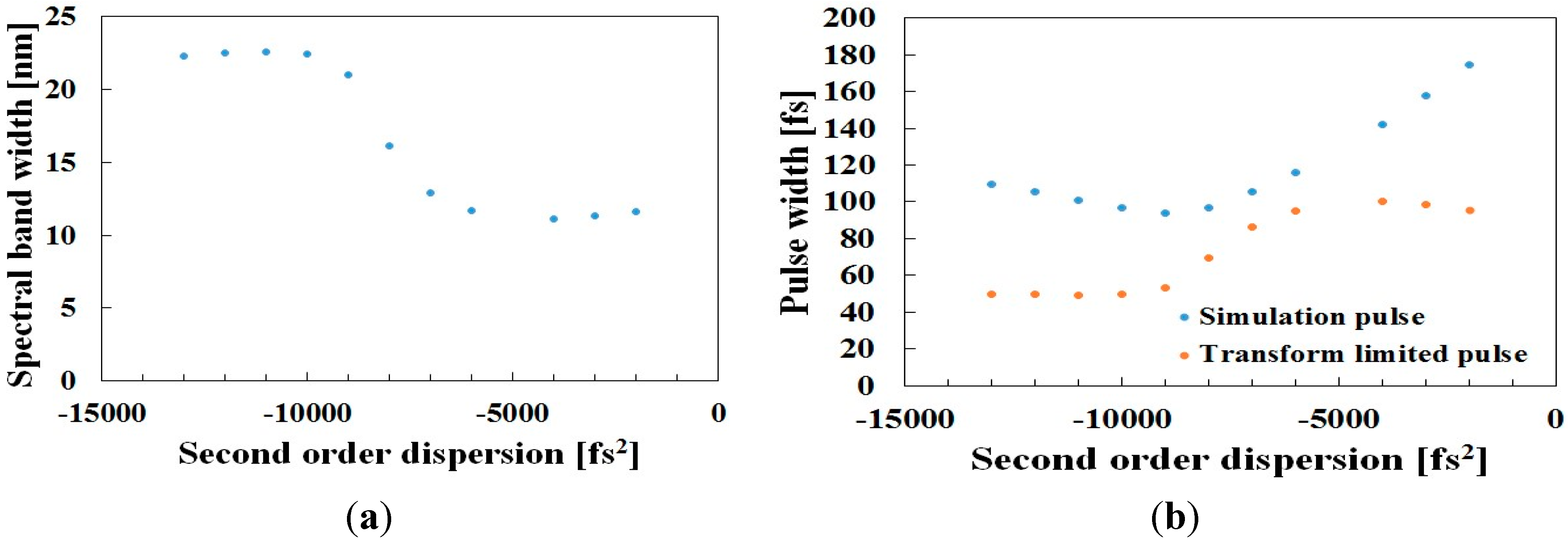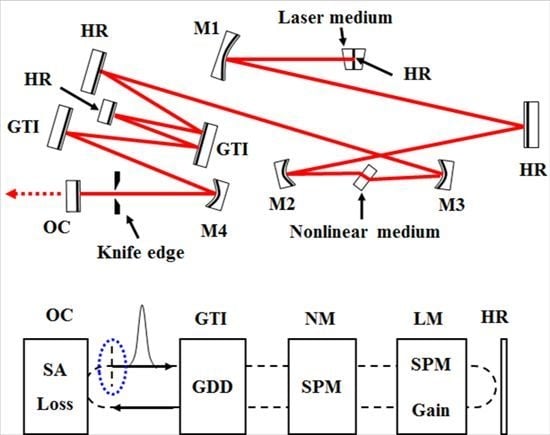1. Introduction
Spectrum filters are usually used to synthesize broad lasing spectra or ultrashort pulses by suppressing the peak laser gain spectrum. However, to realize a broad lasing spectrum, spectral bandwidths comparable to that of the gain spectrum have been previously achieved using a Ti:sapphire laser [
1,
2,
3,
4]. The lasing spectra thus obtained are, however, limited by the gain spectrum. Spectral broadening inside the mode-locked laser cavity, which occurs as a result of nonlinear effects caused by the use of highly nonlinear intra-cavity media, is advantageous in obtaining ultrashort pulses directly from a laser oscillator. Such short pulses are realized by screening out the large dispersion from the spectral phase [
5]. Moreover, intra-cavity spectral broadening is effective in further increasing the nonlinear effects.
We used a Yb:YAG crystal as the laser gain material to demonstrate for the first time the generation of ultrashort pulses beyond the gain spectrum limit directly from the mode-locked laser by using a highly nonlinear intra-cavity medium [
6,
7,
8,
9]. Several Yb-doped laser gain media with wide gain bandwidths beyond 10 nm have been reported. Even though the Yb:YAG laser has a relatively narrow gain bandwidth of approximately 9 nm and a corresponding long Fourier transform-limited pulse width of 120 fs, it has high thermal conductivity, robustness, and easy applicability.
A pulse width of 65 fs and output spectrum width of 17 nm were obtained at the gain peak, which is almost half of the Fourier transform limit of the gain spectrum bandwidth at the peak [
9]. Without Gires-Tournois interferometer (GTI) mirror compensation, output spectrum widths of approximately 30 nm were also obtained. Moreover, Uemara
et al. [
10] achieved an approximately 30 fs pulse width by using the conventional method of introducing a spectrum filter in the laser cavity such that the output spectrum at the first gain peak of 1029 nm is suppressed and the output at the second peak of 1050 nm is increased.
These results demonstrate the potential to generate ultrashort pulses that can overcome the limit of the gain spectrum of any material by combining a novel scheme with the conventional method. In this study, we theoretically analyze lasing spectra and pulses in the mode-locked Yb:YAG laser with a highly nonlinear intra-cavity medium. The results agree qualitatively with the experimental results from previous reports.
2. Numerical Model for a Kerr-Lens Mode-Locked Laser with a Highly Nonlinear Intra-Cavity Medium
Figure 1 shows a schematic of the Kerr-lens mode-locked Yb:YAG laser with a highly nonlinear intra-cavity medium [
6,
9]. For the theoretical analysis of this laser, we used a nonlinear Schrodinger equation as follows:
where
TR is the round-trip time of the laser cavity,
A is the envelope of the oscillating electric field,
T is the time of propagation,
t is the time corresponding to the pulse width,
lc is the cavity loss, and β
2 is the second-order dispersion (SOD). The saturated gain
g(
P)is given by:
where
g0 is the unsaturated gain,
P is the intra-cavity power, and
Psat is the saturation power of the gain medium. The saturable gain with bandwidth Ω
g is assumed to be parabolically frequency-dependent. The fast saturable absorption (SA) induced by the Kerr-lens effect has a time-dependent loss and is modeled by the following expression:
Here,
Psat is the saturation power of the fast saturable absorber. Higher-order dispersions are neglected in the simulation. A nonlinear parameter that corresponds to the effectiveness of self-phase modulation (SPM) in the gain medium and nonlinear medium is given by:
where
L is the length of the medium,
n2 is the nonlinear refractive index of the medium, λ is the laser wavelength 1030 nm, and
S is the cross-sectional area of the medium. To model the nonlinear effect for spectral broadening, the SPM in the gain and nonlinear media was included. Finally, ψ is the phase shift per round-trip of the laser [
11,
12,
13,
14,
15,
16].
Figure 2 shows the block model of the mode-locked Yb:YAG laser with a highly nonlinear intra-cavity medium and shows how the optical elements can be distributed into four separate units. The laser pulse experiences changes at each unit because of group delay dispersion (GDD), SPM, gain, loss, and SA. A knife edge was installed in front of an output coupler (OC), which induces SA by the Kerr-lens effect. We considered dispersion only in one unit, and ignored gain in the nonlinear medium. The first segment “OC” constitutes the OC with a cavity loss (Loss) and a fast saturable absorber; the second segment “GTI” constitutes the GTI mirror with GDD; the third segment “NM” comprises the nonlinear medium with an SPM; and the fourth segment “LM” comprises the laser gain medium with an SPM and the saturable gain (Gain). The pulse propagation was numerically solved using the split-step Fourier method in each segment. In the gain medium, pulse propagation was conducted in two steps: First, only Gain was evaluated in the Fourier domain with SPM set to 0, and then, SPM was evaluated in the time domain with GDD set to 0. In the OC and GTI segments, SA and Loss were evaluated in the time domain, and GDD was evaluated in the Fourier domain.
Figure 1.
Schematic of the Kerr-lens mode-locked Yb:YAG laser with a highly nonlinear intra-cavity medium. HR: High reflector mirror, GTI: Gires-Tournois interferometer, OC: Output coupler.
Figure 1.
Schematic of the Kerr-lens mode-locked Yb:YAG laser with a highly nonlinear intra-cavity medium. HR: High reflector mirror, GTI: Gires-Tournois interferometer, OC: Output coupler.
Figure 2.
Block model for the mode-locked laser with a highly nonlinear intra-cavity medium. LM: Laser medium, HR: High reflector, NM: Nonlinear medium, GTIM: Gires-Tournois interferometer, OC: Output coupler.
Figure 2.
Block model for the mode-locked laser with a highly nonlinear intra-cavity medium. LM: Laser medium, HR: High reflector, NM: Nonlinear medium, GTIM: Gires-Tournois interferometer, OC: Output coupler.
3. Simulation Results
In the simulation, the unsaturated gain
g0 was 7, corresponding to a pump intensity of approximately 100 kW/cm
2 and Ω
g was 9.6 THz, corresponding to a gain bandwidth of 7.7 nm. The gain bandwidth of an actual Yb:YAG laser at a gain peak of 1030 nm is estimated to be 6–9 nm [
17,
18]. We chose a gain bandwidth of 7.7 nm, which is the middle of the range. The lengths of the gain and nonlinear media were 1 mm and 3 mm, respectively. The laser beam cross-sections at the gain and nonlinear media were chosen to be 1000 μm
2 and 3000 μm
2, respectively. The saturation power of the fast saturable absorber was chosen to be 10 kW. To compute gain, loss, and SA, these parameters were selected such that the pulse does not narrow beyond the Fourier transform-limited pulse width of the gain spectrum. The nonlinear refractive indexes of the gain and nonlinear media were 69 μm
2/GW and 480 μm
2/GW, respectively. The SOD was introduced to the GTI mirror; therefore, the SOD in the cavity was twice that of the mirror. The above-mentioned parameters are appropriate for those in the experiment [
6,
9]. We assumed hyperbolic secant-shaped pulses with a pulse width of 120 fs as the initial condition. This pulse width was broadened to 1 ps, but the output waveforms converged. The laser cavity loss was caused only by the transmission of the OC without the intrinsic loss.
In the analysis, the SOD of the laser cavity was varied from −1000 fs
2 to −15,000 fs
2.
Figure 3a,b show the pulse profiles and the corresponding output spectra, respectively. The transform-limited pulse in
Figure 3b was assumed as the normalized hyperbolic secant-shaped pulse with a pulse width of 120 fs. The laser cavity loss
lc was chosen to be 40%.
Figure 4a shows the output spectrum width and
Figure 4b shows the output pulse width and the Fourier transform-limited pulse width of the output spectrum. The output spectra converged for all SOD values considered in the simulations. At an SOD of −12,000 fs
2, the shortest pulse width of 161 fs was obtained with an output spectrum width of 7.8 nm. The pulse energy in the cavity was calculated to be 36 nJ, which is almost half of the experimental value of 62 nJ. The normalized gain spectrum shown in each of the figures is obtained by
, where ω
c is the center frequency. The saturable gain is parabolic, and it is 0 when ω = ω
c + Ω
g. Thus, G(ω
c + Ω
g) = 1/
e, and the full width at 1/
e of the normalized gain spectrum is 11 nm. Although the maximum output spectral bandwidth was close to the width at 1/
e of the normalized gain spectrum, these results were limited within the gain spectrum probably because the nonlinearity was lower compared with that of the experiments.
Figure 3.
(a) Output spectra and (b) output pulse profiles for a cavity loss of 40%.
Figure 3.
(a) Output spectra and (b) output pulse profiles for a cavity loss of 40%.
Figure 4.
(a) The spectral bandwidth and (b) the output pulse width and the Fourier transform-limited pulse width of the corresponding output spectrum as a function of SOD for a cavity loss of 40%.
Figure 4.
(a) The spectral bandwidth and (b) the output pulse width and the Fourier transform-limited pulse width of the corresponding output spectrum as a function of SOD for a cavity loss of 40%.
Figure 5 and
Figure 6 show the simulation results for a cavity loss of 2%. At SODs of −14,000 fs
2 and −15,000 fs
2, the output spectra did not converge, unlike the results for the 40% cavity loss. At an SOD of −1000 fs
2, the simulation results converged and double-pulse mode-locked laser oscillation occurred. At an SOD of −5000 fs
2, the results converged and triple-pulse mode-locked laser oscillation occurred. At an SOD of −9000 fs
2, the shortest pulse width of 94 fs was obtained with a spectral width of 21 nm. The edges of the output spectra were considerably broader than the full width at 1/
e of the normalized gain spectrum, thus overcoming the limit of the gain medium. The pulse energy was 143 nJ, which is approximately twice that in the experiments. At the same SOD, the pulse widths for the 2% cavity loss were shorter than those for the 40% cavity loss and the corresponding spectral bandwidths were broader than those for the 40% cavity loss. For the 2% cavity loss, when the SOD was between −6000 fs
2 and −13,000 fs
2, the spectral widths were broader than the gain spectral width and the corresponding pulse widths were shorter than the Fourier transform limit of the gain spectrum.
Figure 5.
(a) Output spectra and (b) output pulse profiles for the SOD varied from −1000 fs2 to −5000 fs2; (c) Output spectra and (d) output pulse profiles of the SOD varied from −6000 fs2 to −13,000 fs2. The cavity loss is 2%.
Figure 5.
(a) Output spectra and (b) output pulse profiles for the SOD varied from −1000 fs2 to −5000 fs2; (c) Output spectra and (d) output pulse profiles of the SOD varied from −6000 fs2 to −13,000 fs2. The cavity loss is 2%.
Figure 6.
(a) The spectral bandwidth and (b) the output pulse width and Fourier transform-limited pulse width of the output spectrum as a function of SOD for a cavity loss of 2%.
Figure 6.
(a) The spectral bandwidth and (b) the output pulse width and Fourier transform-limited pulse width of the output spectrum as a function of SOD for a cavity loss of 2%.
Figure 7a shows the shortest output pulse widths and the transform-limited pulse widths of the output spectra as a function of the peak intensity at the nonlinear medium. The peak intensity varied with cavity loss. As the figure shows, the pulse width reduces as the intensity increases. Above a peak intensity of 20 GW/cm
2, the pulse widths are shorter than the transform limit of the gain spectrum. At a peak intensity of 49 GW/cm
2, the shortest pulse width is 94 fs, which is twice that of the transform-limited pulse width of the corresponding output spectrum. With a further increase in peak intensity, the pulse width shortens and the spectral width widens. However, the required SOD for the shortest pulse generation is several times larger than that for the experiments. The pulse broadening of the output compared with the transform-limited pulse increases as the peak intensity increases. Higher dispersion compensation may be required to obtain the transform-limited pulse of the output spectrum.
Figure 7b shows the pulse energy in the cavity and SOD that are required for the shortest pulse generation. As the peak power increases, the pulse width decreases with the increase in pulse energy.
Figure 7.
(a) Output pulse width and the Fourier transform-limited pulse width of the output spectrum; (b) Pulse energy and SOD for the shortest pulse generation.
Figure 7.
(a) Output pulse width and the Fourier transform-limited pulse width of the output spectrum; (b) Pulse energy and SOD for the shortest pulse generation.
4. Conclusions
The behavior of nonlinear effects on ultrashort pulse propagation in a mode-locked Yb:YAG laser with a highly nonlinear intra-cavity medium was theoretically analyzed using a nonlinear Schrodinger equation. A maximum output bandwidth of 21 nm and a shortest pulse width of 94 fs were obtained at a second-order dispersion (SOD) of −9000 fs2 when the focus intensity at the nonlinear medium was 49 GW/cm2 for a cavity loss of 2%. An output spectrum broadening of more than twice the gain spectral width was achieved, and the pulse width narrowed beyond the Fourier transform-limited pulse width of the gain spectrum. The simulation results agree qualitatively with the experimental results, thus suggesting the potential of spectral broadening and pulse shortening using highly nonlinear intra-cavity media.
However, the shortest pulse width in our simulation was approximately twice that of the transform-limited pulse width of the output spectrum. Moreover, the absolute values of the optimum SOD for the shortest pulse generation were several times larger than those required for the experiments. This is likely because of the assumption on the gain spectrum in the simulation. That is, although the base gain spectrum of the actual Yb:YAG laser lies in a wide frequency range, in the present model, we assumed that the gain spectrum is parabolically frequency-dependent and is negative in a range away from the center frequency. Therefore, stronger self-phase modulation compared with that for the experiments is necessary to exceed the gain spectrum, and the corresponding values of SOD become larger than those in the experiments. Further analysis on other nonlinear effects and compensation of high dispersion is necessary to achieve the shortest pulse width and the broadest bandwidth by overcoming these drawbacks.













